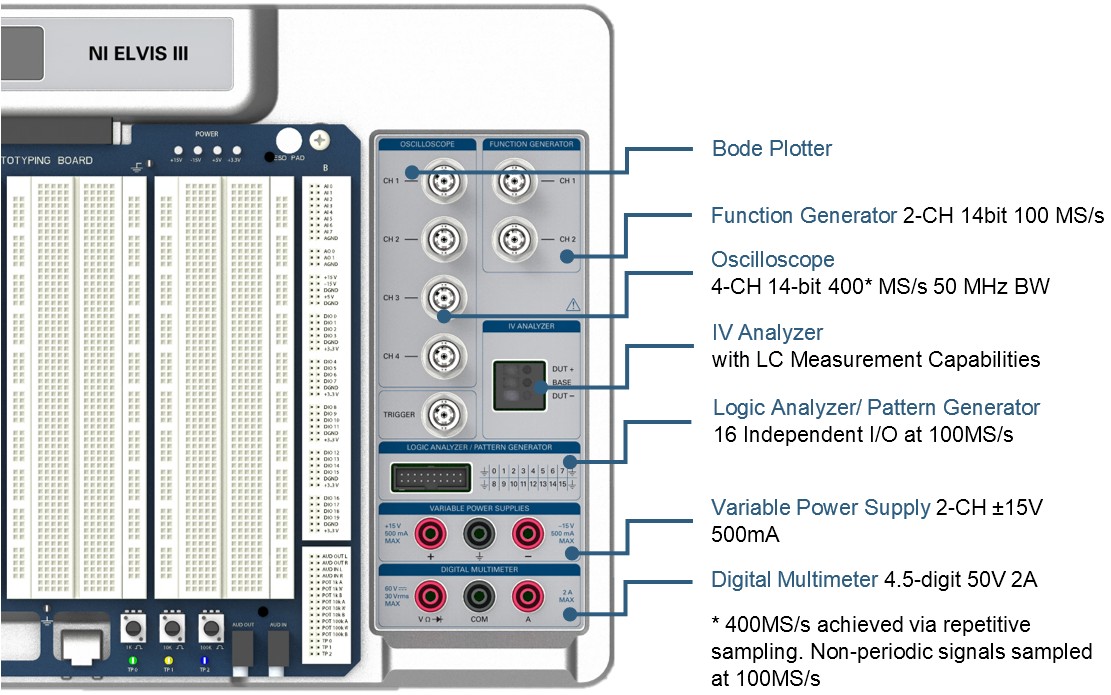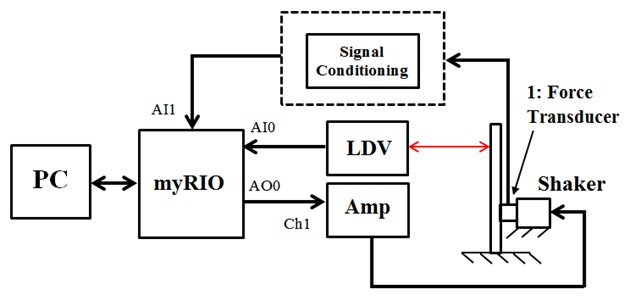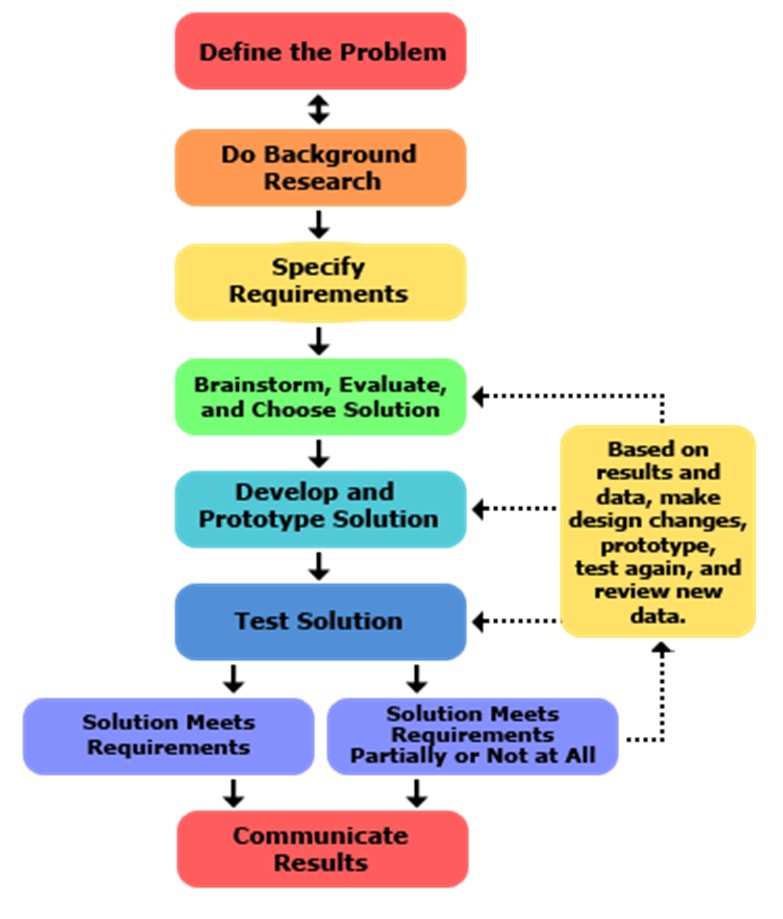Teach Students How to Innovate
Overview
Contents
Concepts in Context
Projects that inherently challenge students to employ innovative design thinking often involve interacting with an unknown process or device. Students are encouraged to understand the unknown though theory, simulation, and experimentation; however, projects that introduce the unknown in the messy, multi-system environment it exists in naturally tend to challenge the students to be much more innovative. Designing a test in this style not only requires an understanding of specifications, the limitations of the equipment, and the fundamental concepts being applied but it also requires students to contend with outside factors and how one change can have a cascading effect on the experimental setup.
Figure 1: Topic distribution of the Fundamentals series of courses
Take, for example, the University of Virginia teaching a series of courses in electrical and computer engineering they call the Fundamentals1 . Fundamentals seeks to convey the fundamentals of electrical engineering including circuits, electronics, and signals and systems all in one series of courses that iteratively build on each other. So rather than teaching Operational Amplifiers as an individual topic, the students analyze the signals that go into the OpAmp and how those characteristics influence the performance of the OpAmp. The first semester culminates in students creating a four-input summing amplifier, representing the combined knowledge of simple circuits, OpAmps, and signals to fully comprehend every element of the project. The University of Virginia, since implementing this change in course structure, has seen a 15% increase in concept inventory scores and has seen significant improvement in the innovative quality of student design projects at the end of the year2.
Figure 2: Fundamentals I at UVA final summing amplifier project
To most effectively analyze concepts in this manner, not only do students need the ability to effectively instrument and analyze the experiment, but precise control and the ability to manipulate the type and behavior of the inputs to the system are critical to a student’s understanding. The NI ELVIS III is the only engineering laboratory solution that combines 7 traditional instruments with fully customizable I/O, enabling complete implementation of the concepts in context approach.
Figure 3: NI ELVIS III instrumentation specifications
Projects that Spur Teamwork
The development of a reliable, repeatable test challenges students to plan as a group, properly define test steps, and provide an output that communicates relevant information about test conditions, whether it passed or failed and why. These repeatable experiments require students to consider and monitor elements outside of the major focus of the test.
Take, for example, the experimental methods course3 at Georgia Institute of Technology. One of the important concepts taught is vibrations of a free and forced beam. In this experiment, students need to be able to monitor a force transducer, a laser doppler velocimeter, and control a shaker all while ensuring the accuracy of the amplifier and signal conditioning circuitry. While the concept being taught is singular, measuring a beam’s forced response, it requires a multi-faceted approach to developing a sound experiment which requires multiple elements to be monitored at once. Georgia Tech’s answer to this is a laboratory solution that exposes both instruments and controls and can serve as an interface to more than one student at a time. This degree of teamwork and level of sophistication in a project gives students the confidence they need to tackle harder problems after graduation4.
Figure 4: Georgia Tech ME3057 Vibrations project diagram
The NI ELVIS III combines instrumentation and control specifically to service experiments and learning experiences like this one. Students have a need to create a controller which precisely shakes a beam yet the amplifier for the shaker and the signal conditioning for the force transducer needs to be stable and accurate to ensure a successful experiment. Instruments such as a 4-channel oscilloscope and a 16-channel logic analyzer give students the security of knowing the results of their experiment are valid.
Figure 5: NI ELVIS III control I/O specifications
The Engineering Method
Figure 6: The Engineering Method
The process of designing a test and understanding the components used in it are not mutually exclusive. In fact, the engineering design process requires for there to be a tight handshake between developing a prototype solution, testing it and using results and data to make modifications. Such a tight relationship between these steps requires tools that combine the elements of design and test.
Take, for example, the third and last semester of the University of Virginia’s Fundamentals series5. The final project is to build an electrocardiogram or EKG. The students use their knowledge accumulated over three semesters of electrical engineering fundamentals education to understand and apply knowledge of complex signals, data acquisition, instrumentation amplifiers, and data processing. These students really do go through the engineering method as they will need to realize that the trace length and components they select really matters to acquire a clean, intelligible signal. After completing their designs and testing it out for the first time the students realize they have a problem: the signal is nearly completely noise and not the expected output. At this point the students are within the ‘test solution’ phase of the engineering method and need to go back to the ‘brainstorm, evaluate, and choose solution’ phase. Because the students have an exemplary understanding of signals in the context of circuits and systems, they conclude that the noise is being introduced through a combination of the power supply and the room lights. After passing that through a digitally implemented FIR filter, the students suddenly see their real heart rate and communicate the results to their professor.
Figure 7: Output waveform of EKG in LabVIEW
By following the engineering method and having the flexibility to prototype and implement elements digitally, students realize how to resolve issues in their project and report on lessons learned.
Conclusion
NI ELVIS III enables you to teach innovation by allowing you to challenge students with more projects that follow the engineering design process.
Considering the above scenarios, students would get exposed to a wealth of foundational and complex topics. Handled in the traditional sense of first working with all of the components then, if time allows, trying to combine all of them into a single project, may cost time and lack the context needed to engage students. If instead this were realized through several projects throughout a course, students will remain challenged and you will successfully address several student learning outcomes identified by the Washington Accord6, namely:
(a) an ability to apply knowledge of mathematics, science and engineering
(d) an ability to function on multidisciplinary teams
(e) an ability to identify, formulate, and solve engineering problems
(k) an ability to use the techniques, skills, and modern engineering tools necessary for engineering practice
Next Steps
References
- Dr. Powell, H. C., Prof. Williams, R. D., & Dr. DeLong, T. (2017). Assessment of Comprehension Retention in a Modern Electrical and Computer Engineering Curriculum. 2017 ASEE Anual Conference & Exposition. Columbus: American Society for Engineering Education. Retrieved from https://www.asee.org/public/conferences/78/papers/19441/view
- Dr. Powell, H. C. (2017, November). Rethinking Electronics Fundamentals. Retrieved from National Instruments: http://download.ni.com/evaluation/academic/UVA_Case_Study.pdf
- Dr. MacNair, D., & Sadegh, N. (2017). ME 3057 Experimental Methods Laboratory. Atlanta, Georgia: Georgia Intitute of Technology. Retrieved from https://www.me.gatech.edu/files/ug/me3057.pdf
- Dr. Donnell, J. A., Varney, P., Dr. MacNair, D., & Prof. Ferri, A. A. (2017). Optimizing Efficiency and Effectiveness in a Mechanical Engineering Laboratory using Focused Modules. 2017 ASEE Annual Conference & Exposition. Columbus: American Society for Engineering Education. Retrieved from https://www.asee.org/public/conferences/78/papers/19189/view
- Dr. Powell, H. C. (2017, November 16). Rethinking Electronics Fundamentals - Reversing Attrition While Improving Concept Retention at the University of Virginia. ECEDHA ECE Webinar. ECEDHA. Retrieved from http://www.ecedha.org/ece-media/ece-webinars/national-instruments-webinar-11-16-17
- International Engineering Alliance. (2014, June). 25 Years of the Washington Accord. Retrieved from Washington Accord: http://www.ieagreements.org/assets/Uploads/Documents/History/25YearsWashingtonAccord-A5booklet-FINAL.pdf






